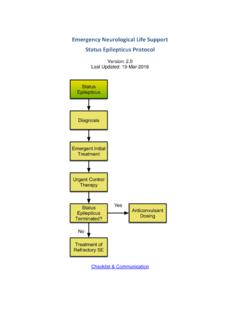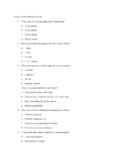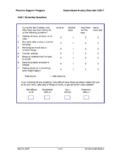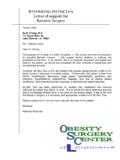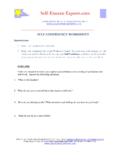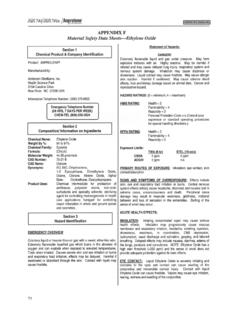Transcription of Emergency Neurological Life Support Traumatic …
1 Emergency Neurological life Support Traumatic Brain Injury Version: Last Updated: 19-Mar-2016. Traumatic Brain Injury Table of Contents Emergency Neurological life Support .. 1. Traumatic Brain 1. Checklist .. 3. 3. Analgesia and Sedation .. 4. Avoid Hypoxia and Hypotension .. 5. Keep SBP > 90 mmHg, O2 Sat > 90% .. 5. Coagulopathy .. 6. Recognition and treatment .. 6. Diagnosis .. 7. What constitutes TBI? .. 7. Hemicraniectomy .. 8. And other surgical interventions .. 8. Initial Hospital Management .. 9. If not done 9. Medical Therapy ..10. Evaluation and management in the field ..11. Control and prevention ..12. Treat Elevated ICP ..13. ICP Monitoring- Indications and treatment algorithm ..13. Traumatic Brain Injury Page 3.
2 Checklist Secure Airway SBP > 90 mmHg and O2 saturation > 90%. C-spine precautions Head CT. Treat herniation Neurologic examination Communication Patient age and mechanism of injury Pre-injury health, including home medications Head CT findings Post resuscitation GCS with detailed neurologic exam Completed interventions Focal motor findings Coagulation status and other pertinent laboratory findings Other injuries State of cervical spine - cleared, not cleared, injury Current vital signs Traumatic Brain Injury Page 4. Analgesia and Sedation Patients with severe TBI typically require tracheal intubation for airway protection. Depending on the level of consciousness and agitation, sedation is often required.
3 Concomitant skull and body injuries also require analgesia (rib fractures for example). See the ENLS protocol Airway, Ventilation and Sedation for a discussion on medications and methodology. For extubated patients care must be given to prevent oversedation with respiratory depressant medications (opiates and IV benzodiazepines). Traumatic Brain Injury Page 5. Avoid Hypoxia and Hypotension Keep SBP > 90 mmHg, O2 Sat > 90%. Hypotension (SBP < 90 mmHg in adults; < 70 mmHg + age X 2 for children) in the setting of TBI is harmful. At any point in the initial encounter, treat with IV fluid bolus (500 ml 1 L of crystalloid in adults; 20 ml/kg for children). Avoid use of D5W. Oxygenation should be maintained with supplemental oxygen as needed to keep O2 Sat >.
4 90%. Avoid hyperoxia. Traumatic Brain Injury Page 6. Coagulopathy Recognition and treatment Indicated if known or suspected coagulopathy: recent elevated PT/INR/PTT. low platelets history or physical examination consistent with end-stage hepatic or renal disease on anticoagulant therapy on antiplatelet therapy Consider the following: Plasma or PCC and vitamin K - for patients on warfarin Consider FFP for patients with liver dysfunction with coagulopathy Platelets - for patients with conditions with low or malfunctioning platelets DDAVP - for patients with end-stage renal disease or on certain anti-platelet agents See ENLS reference Pharmacotherapy for detailed antidotes and dosing. Sidebar common pitfalls In most cases, reversal can begin immediately according to empiric guidelines and does not require laboratory values or confirmation.
5 Reversal of anticoagulation is a complex subject, and in some cases, such as in patients with hemophilia and other bleeding dyscrasias, it may be necessary to obtain specialist consultation from a hematologist. Reversal of antiplatelet agents such as ASA, clopidogrel and ticlopidine is controversial. Evidence for platelet transfusion in this cohort is equivocal. Some authors recommend the use of DDAVP despite lack of conclusive benefit. Traumatic Brain Injury Page 7. Diagnosis What constitutes TBI? Traumatic Brain Injury (TBI): Severe TBI: Mechanism consistent with TBI and/or physical signs of trauma in unconscious patient, with a Glasgow Coma Scale (GCS) < 9. It is important to consider other treatable causes of decreased level of consciousness.
6 Every attempt should be made to identify and reverse vascular, metabolic, infectious, environmental, toxicological and other non- Traumatic causes. These causes may co-exist with TBI. The GCS should be obtained through interaction with the patient ( by giving verbal commands or if those unable to respond by applying a painful stimulus). The GCS should be assessed after appropriate resuscitation and before the administration of sedative or neuromuscular blocking agents Diagnosis of TBI - recognition of TBI depends on consideration of: Physiology ( GCS). Anatomy (scalp laceration, depressed skull fracture). Mechanism of injury ( fall > 20 feet, MVA > 30 mph). Concussion Concussion is recognized as a clinical syndrome of biomechanically induced alteration of brain function, typically affecting memory and orientation, which may involve loss of consciousness (LOC).
7 This protocol will not address concussion further Topic Co-Chairs: Rachel Garvin, MD. Chitra Venkatasubramanian, MD. Angela Lumba-Brown, MD. Chad M. Miller, MD. Traumatic Brain Injury Page 8. Hemicraniectomy And other surgical interventions Surgical removal of hematoma (subdural, epidural, intracerebral) depend on the patient's clinical status and the judgment of treating physicians. Some general guidelines include Epidural hematoma or subdural hematomas > 1 cm thick and midline shift > 5 mm Intracerebral hemorrhage > 50 cc in volume or > 3 cm in diameter Penetrating skull injury Depressed skull fracture Refractory ICP. Decompressive hemicraniectomy, either unilateral or bilateral, in select patients can markedly lower ICP and likely improve outcomes; proper patient selection is still being elucidated.
8 Traumatic Brain Injury Page 9. Initial Hospital Management If not done prehospital Spinal precautions to be maintained at all times Advanced airway management to ensure: a) airway protection to maintain oxygen saturation > 90%, b) control of ventilation (if inadequate or inappropriate). See ENLS. protocol Airway, Ventilation and Sedation. Obtain CXR. Continuous monitoring of oxygenation, blood pressure, cardiac rhythm and PCO2. Obtain parenteral access (IV or IO). Diagnose hypoglycemia: if hypoglycemic give D50% 50 ml IV. Obtain CT Head without contrast Consider spine imaging; see ENLS protocol Traumatic Spine Injury. Neurosurgical consultation may be necessary depending on the severity of the injury and the patient's clinical status.
9 Findings that should prompt neurosurgical consultation include: GCS < 13. The patient has seizures Lateralizing findings on Neurological examination, including unequal pupils or focal weakness Abnormal head CT scan Head CT is not consistent with clinical signs CSF leak, or signs of basal skull fracture Penetrating skull injury Cerebrovascular injury Suspected cervical spine injury Sidebar common pitfalls Although a Glasgow Coma Scale of 8 or less during the initial evaluation is an indication for endotracheal intubation; severe extracranial injuries or a rapidly declining mental status may also be indications. Patient can be ventilated with 100% O2 until ABG values are available. Any adjustments should maintain SaO2 > 90%.
10 Traumatic Brain Injury Page 10. Medical Therapy Initial treatment may include: Positioning: ensuring head midline and at 30 degrees HOB elevation if able Analgesic - Fentanyl preferred, ketamine is an option Sedation - Propofol or precedex, depending on patient's vital signs (benzodiazepines are not recommended in TBI patients). Both agents likely drop MAP which will decrease CPP (MAP-ICP). Transfuse RBCs if active bleeding or hemoglobin < 7 gm/dl Use pressors if needed to maintain Goal CPP of 50-70 mmHg Neuromuscular blockers only if shivering or difficulty ventilating patient Control body temperature; avoid fever. Consider temperature management protocol Mannitol or hypertonic saline: Administer 20% mannitol g/kg IV as a rapid (5.)
